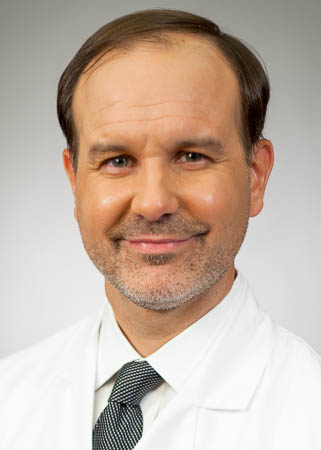Overactive Bladder
Quick Facts
Overactive Bladder Doctors
Overactive bladder is a condition that causes sudden urges to urinate. This urge may be difficult to stop and may cause an involuntary loss of urine (urge incontinence).
Some people with overactive bladder may limit their activities and social life to accommodate their condition. However, there are many treatment options available that can help restore normal bladder function.
Behavioral adjustments are usually the first step in OAB treatment. If those don’t alleviate symptoms, there are medications for OAB. Sometimes patients will need to try more than medication to find the one best suited for them. If medications don’t work, there are more advanced treatments like nerve stimulation and bladder injections.
Overactive Bladder Symptoms
Symptoms of OAB include:
- Sudden urges to urinate
- Urge incontinence (leaking urine following a sudden urge to urinate)
- Frequently urinating (usually 8 or more times within 24 hours)
- Getting up two or more times at night to urinate
You should see a doctor if any of these symptoms are bothersome to you or disrupt your work, social life, or everyday activities.
Overactive Bladder Causes
 Overactive bladder occurs when the muscles of the bladder begin to push urine out involuntarily even when the bladder isn’t full. The involuntary muscle contracting that causes this is what creates the sudden urge to urinate.
Overactive bladder occurs when the muscles of the bladder begin to push urine out involuntarily even when the bladder isn’t full. The involuntary muscle contracting that causes this is what creates the sudden urge to urinate.
There are several conditions that may contribute to overactive bladder symptoms including:
- Neurological disorders (including multiple sclerosis or stroke)
- Diabetes
- Medications that cause increases in urine production or require drinking lots of fluids when taking them
- Urinary tract infections may cause similar symptoms to OAB
- Bladder tumors or bladder stones
- Bladder obstructions such as BPH or constipation
- Excessive alcohol or caffeine
In some cases, the exact cause of overactive bladder is unknown.
Overactive Bladder Risk Factors
Age is one of the biggest risk factors for OAB. As you age, you are also more likely to develop other diseases and conditions that could contribute to OAB.
Overactive Bladder Diagnosis
If you have signs and symptoms of overactive bladder, your doctor will usually check for an infection first.
Your doctor may also:
- Review your medical history
- Perform a physical exam, including your abdomen and genitals
- Perform a urinalysis (urine test) to look for signs of an infection or abnormalities
Other, more advanced testing may be necessary if initial treatment options like behavior changes or medication don’t help.
These include tests to review:
- How much urine is left in the bladder after urination
- The flow rate of urine from the bladder
- Bladder pressure when the bladder is full
These tests and exams will help your doctor recommend the best treatment options.
Overactive Bladder Treatment Options
Treating overactive bladder will vary based on the severity of your condition and other treatment options you’ve already tried. Often, it’s a combination of treatments that works best.
Behavior interventions
Behavior interventions are usually the first recommendation for OAB treatment. These include:
- Strengthening pelvic floor muscles: Exercises that strengthen the pelvic floor muscles (including Kegel exercises) may help stop the involuntary contractions of the bladder. A pelvic floor physical therapist can work with you to make sure you’re doing these exercises correctly. It may take six to eight weeks to see improvement.
- Maintain a healthy weight: People who are overweight may see some symptom relief from losing weight.
- Bladder training: This approach helps you resist the urge to urinate and increase the urine your bladder can hold. Your doctor can recommend a bladder training schedule to follow.
Overactive Bladder Medications
Medications that help relax the bladder may reduce sudden urges. The most common medications for OAB include:
- Tolterodine (Detrol, Detrol LA)
- Oxybutynin (Ditropan XL)
- Oxybutynin patch (Oxytrol)
- Oxybutynin gel (Gelnique, Gelnique 3%)
- Trospium (Sanctura)
- Solifenacin (Vesicare)
- Darifenacin (Enablex)
- Mirabegron (Myrbetriq)
- Fesoterodine (Toviaz)
Injections
Injections of Botox (OnabotulinumtoxinA) into the bladder may help reduce urges by partially paralyzing the bladder muscles. This therapy may last five months or more, but repeat injections will be needed to maintain bladder control. Your doctor will discuss the possible side effects of bladder injections including retention.
Electrical Nerve Stimulation
Also known as a “bladder pacemaker,” these small devices send electrical pulses that help strengthen the nerve connections that control bladder function. Axonics and Interstim are two types of devices that stimulate the sacral nerve to help control OAB symptoms.
Percutaneous tibial nerve stimulation (PTNS) can be helpful as well. It’s a non-surgical treatment that is performed in the office. A small pulse of electricity is sent to the tibial nerve near the ankle, which travels up the nerve to the sacral nerve plexus. Bladder function is controlled by the sacral nerve plexus.
Overactive Bladder Prevention (OAB Home Remedies)
Adopting healthy lifestyle choices may reduce the chances of overactive bladder. These include:
- Maintaining a healthy weight
- Exercising daily (even a 20 or 30-minute walk)
- Limiting caffeine and alcohol intake
- Quitting Smoking
- Managing other conditions like diabetes
- Strengthening the pelvic floor muscles through Kegel exercise or pelvic floor physical therapy.





